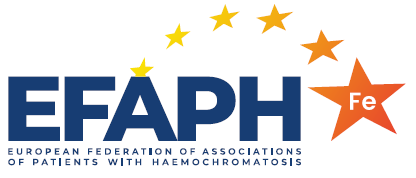1. Geographical spread of the genetic disease throughout Europe by the migration of the celts and the propagation of the vikings.
2. Prevalence of the genetic defect (homozygosity of the C282Y mutation in the HFE-Gene) located on chromosome 6: about 1:300 in Europe (rising to 1:80 in Ireland). Prevalence of healthy carriers of the heterozygote mutation: about 1:8 in Europe. Penetrance is unknown, about 30% of homozygotes.
3. Early symptoms unspecific: chronic fatigue, joint pain.
4. Without treatment: potentially lethal!
The gradual build-up of toxic iron stores in the organs causes slow progression towards organ damage and in the late stages: cirrhosis and carcinoma of the liver, cardiac failure, diabetes, polyarthritis and hormonal disorders.
5. Diagnosis: simple and non-invasive!
-Blood testing: Transferrin saturation and ferritin.
-Blood or saliva testing: Genetic test (search for the C282Y mutation).
6. Therapy: simple and effective!
-Phlebotomy: initially frequent in order to reduce iron stores to normal level, then regularly lifelong at a rate to maintain normal level and prevent further excess.
7. Prevention is possible and crucial!
-In given individuals: Early blood test for transferrin saturation and ferritin.
-In families: Genetic testing as family screening.
8. Early detection means:
-No more disease symptoms.
-No more reduction in life-expectancy or quality of life.
-No more early death by hepatic cancer or heart failure.
-Reduced costs for the health care systems.
9. Problems of Haemochromatosis patients:
-Underestimation of frequency of the disease by the medical profession.
-Misinterpretation of the non-specific symptoms – delay in making correct diagnosis.
-Lack of standardization of venesection therapy.
-Lack of correct management of family screening.
-Great variability in Europe of costs and reimbursement for genetic testing and venesection therapy.
-Exclusion of certain services of insurance companies.
10. Aims of EFAPH (www.efaph.eu):
-To raise awareness in the medical community and public.
-To promote and share best practices for the same chance of treatment and survival for all patients
-To obtain funding for research concerning haemochromatosis.
Download 10 important points as PDF here
